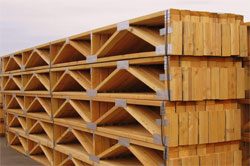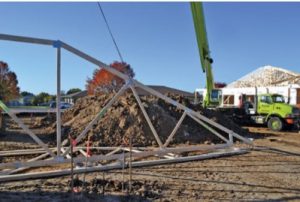In my last article I discussed limiting deflection for barndominium floors. Today I will take this one step further with a floor truss design solution.
Most of us don’t think too much about floors we walk upon – unless they are not level, squeak when we walk on them, or are too bouncy.
Traditionally wood floors have been framed with dimensional lumber (2×6, 2×8, etc.), usually spaced 16 inches on center. Often floor joist span limitations are not based upon lumber strength (ability to carry a given load), but upon deflection criteria. Building codes limit floor deflection to L/360, where “L” is span length in inches.
“Stiffest” (by MOE – Modulus of Elasticity values) commonly used framing lumber is Douglas Fir. A #2 grade Douglas-Fir 2×12, 16 inches on center will span 18’1” when carrying standard residential loads. An L/360 deflection event, would cause the center of one of these floor joists to deflect as much as 6/10ths of an inch!
Lumber is organic, so it varies in consistency from board to board. It also varies in size, and it is not unusual for a dimensional variance of over ¼ inch, from one end of a board to another. Combine this with probability some of these boards will be crowned with bow down and it means an uneven floor will result.
One of our friends lives in a fairly new home. In a hallway between her kitchen and sleeping areas, there is a good ½ inch dip in her floor – more than noticeable when walking across it!
I first used floor trusses in my own post frame shouse (shop/house) 25 years ago. My trusses were designed so they were only 1-1/2” in width (most spans up to this can be done with a 3-1/2” width), but these 30 foot floor trusses are only 24 inches in depth. They allowed me to create some unique interior areas, without a need for interior columns or load bearing walls.
When we built our post frame barndominium in South Dakota, we utilized floor trusses again – here to span 48’ (yes 48 feet)! We live upstairs in a gambrel building, with a clear-spanned half-court basketball court size garage/shop downstairs!
 A few years ago, our oldest son Jake needed a new post frame garage at their home near Knoxville, Tennessee. His mom convinced him this plan would be so much better with a mother-in-law apartment upstairs. We used 4×2 (2x4s turned flat) floor trusses to span a 24 foot width!
A few years ago, our oldest son Jake needed a new post frame garage at their home near Knoxville, Tennessee. His mom convinced him this plan would be so much better with a mother-in-law apartment upstairs. We used 4×2 (2x4s turned flat) floor trusses to span a 24 foot width!
I’d forgotten how fast a trussed floor can be done – until Jake ordered them for a second-floor addition he put on his home when he moved back to South Dakota. In a matter of just a couple of hours, I framed this entire 24 by 32 floor by myself and was ready for sheathing. All ductwork and plumbing can be run through open truss webs, making for nice clean ceilings downstairs.
Considering a full or partial second floor in a post frame building? Don’t want posts or bearing walls down below to prohibit full space utilization? Then floor trusses may be your answer.
Make sure to allow adequate height for truss thickness. As a rough rule-of-thumb, I plan upon one inch of thickness, for every foot of span. While it will nearly always be less, it is better to design for having a couple of extra inches, than not enough.










Are the posts designed to carry the extra load the floor trusses put on them. They are really just designed to support the roof structure right?
Our design program incorporates the extra weight from the floor trusses into the column and footing calculations.
So I have been rough planning my building, but getting material logistics and finding appropriate people to assist in assembly has also given me an issue. In planning a 24wx32lx21h(eaves) building, leaving 12 ft tall first floor and from all engineering charts was recommended 24 ft 16in floor trusses. The plans ha e been adjusted to using permacolumns due to area ground, and 4 ply 2×8 Glu/nai lam columns as they are also finger jointed and guaranteed pretty much best choice.
My question has been how to mount the floor trusses, do I reduce length, and fasten an internal girder and use truss brackets OR one recommendation was using 4-5 in angle iron, bolt to inside of posts, then bolt rim board on and set trusses on top of that(also had suggestions of doubled up lvl and other suggestions) as we had talked about possibly cantilevering 2×12 on trusses to stick out side of building for a deck in future and using diamond piers at outside end of deck after ground work was finalized.
Also as the suggestion was the internal girder would also wrap around sides(and attach with angle iron brackets as well) thus building would be tied in middle together . THEN it was suggested using double trusses in notched posts(my thoughts were the fastenmaster truss lock screws. AND had planned on scissor trusses and 2×6 purlins in brackets.
Also to note was planning this building to use bookshelf girts and use current tech exterior finish of Huber Zip R and fully seal exterior then insulation inside on upstairs using rock wool. Also had plans for conditioned roof.
It’s a lot but over there making is what I do sometimes.
Before we get on to the question – I would strongly discourage you from using nail laminated columns, especially at this eave height. The nailing does not prevent them from acting independently and they will be prone to twist and bend apart from each other. Spend your money on actual glulams. You can save yourself both time and money by pouring piers and using wet set brackets rather than permacolumns.
Your floor truss to column connections and support should be designed by the Registered Professional Engineer who is providing your building plans.
It’s great that you talked about trussed floors and how they’re quick to install. Recently, one of my cousins purchased some land and is interested in building a home on it. My cousin wants to start a farming business on that land, so I think your article could interest him. Thanks for the advice on how trussed floors are an excellent choice for a second-floor addition.
Planning 32×36 two story barn. 6×6 post first level, 2×12 beams with 32’ clear span floor joists set on top. Second level 2×6 stick frame and 4/12 pitch trusses 2’ spacing. Posts are set 42” and spaced at 6’. Is this a feasible plan?
It could be done, but why mix post & stick frame creating a hinge point at second floor line? I would run posts 12′ o.c. and all the way up to the eaves.
Similar to post above, but maybe I have less questions…
24’x36′ pole building with 18′ eaves, using 3-ply 2″x6″ glulam posts at 8′ on center, and being constructed THIS WEEK.
I am installing the second floor after they complete the shell.
I intend to use 2″x12″ LVL bolted onto the posts.
I will set the floor trusses on top of the LVL attached with brackets.
These are 16″ tall, 2″x4″x24′ trimmable on both ends down to 23′.
I’ll frame out for stairs on one end, but otherwise seems simple enough to me and easier than using joist hangers.
What am I missing or mistaken?
It is possible what you propose will work, however you should run it by the engineer who sealed the plans for the building shell to confirm member sizes, connections, adequacy of columns to support added loads and to check column footing capacity (last of these is rarely taken into account and if not can result in columns sinking).
In a post frame construction can you skip concrete slab and frame subfloor / connect floor structure to girts in wall set on a girt on the inside? single story
Provided your building has been engineered without a concrete slab on grade, it is possible to frame a raised wood floor attaching to the wall columns (it will take more than the support of just a wall girt however and footings must be adequate in diameter to carry the added live and dead loads).